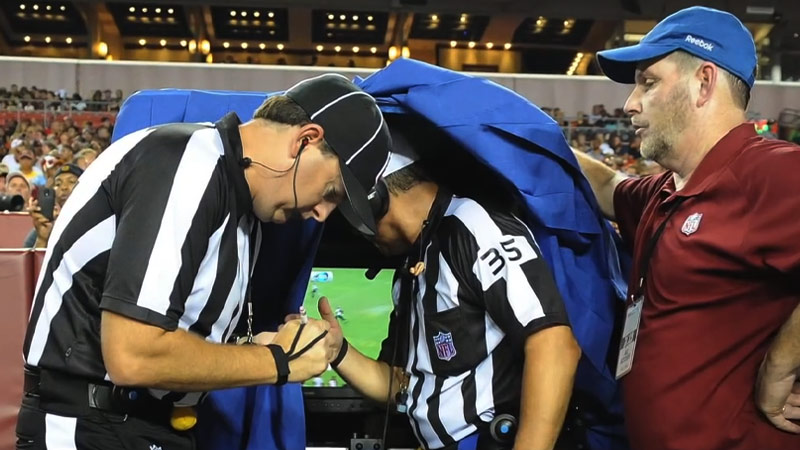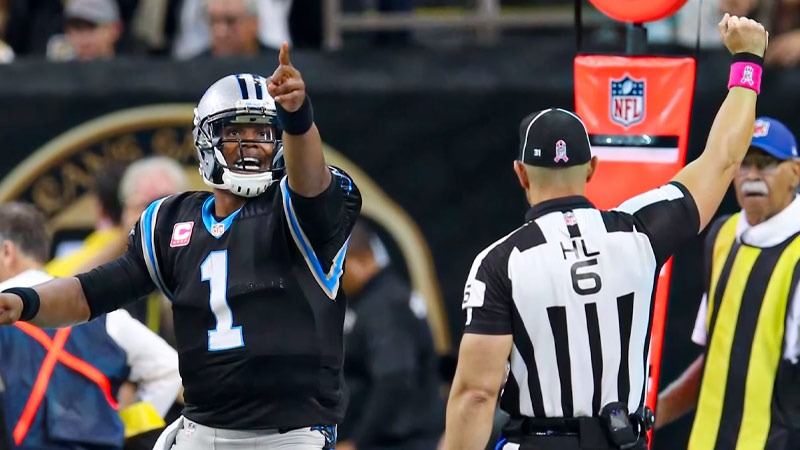In the fast-paced world of American Football, split-second decisions can often determine the course of a game. To ensure accuracy and maintain the integrity of the sport, the implementation of football instant replay rules has become an integral part of the game.
This technology-driven review system has revolutionized the way officiating decisions are made, offering coaches, players, and fans a chance to see critical moments from multiple angles.
In this blog post, we delve into the intricacies of football instant replay rules, addressing some of the most frequently asked questions and shedding light on the impact it has on the game. So, keep calm and stay focused.
What Is Football Instant Replay?
Football instant replay, utilized in American Football, is a technology-driven review system designed to enhance the accuracy of officiating decisions during games.
It involves the use of video footage to review crucial moments, such as touchdowns, turnovers, and controversial calls made by on-field referees.
Coaches or officials can challenge certain decisions, prompting a review by a central officiating authority. This process allows for a closer examination of the events in question, often involving multiple camera angles, slow-motion replays, and zoom-ins.
The aim is to ensure that the correct call is made, reducing human error and enhancing the fairness of the game. Instant replay has become an integral part of American Football, contributing to more precise and informed judgments, while also generating discussions about its impact on the flow of the game.
Football Instant Replay Rules
In American Football, the use of instant replay is governed by specific rules to ensure fair and accurate officiating. Here are the key rules regarding football instant replay:
Challenges
Coaches are typically allowed a certain number of challenges per game. A challenge involves questioning a specific call made on the field.
Challenges can be used for various situations, such as questionable touchdowns, turnovers, or certain penalties. If a coach challenges a call, it triggers the instant replay review process.
Reviewable Calls
Not all calls on the field are subject to review. There is usually a predetermined list of reviewable plays that can be challenged, which may include scoring plays, turnovers, possession changes, and certain penalties.
Review Process
After a challenge is initiated, the game is paused, and the designated officials in a central replay booth review the relevant video footage. They analyze multiple camera angles and slow-motion replays to determine the accuracy of the call.
Criteria for Overturning Calls
To overturn a call on the field, there must be “clear and conclusive evidence” that the original call was incorrect. This means that the video evidence must clearly show that the call was wrong based on the available angles and visual information.
Timing and Timeouts
In most cases, coaches must use one of their team’s timeouts to initiate a challenge. If the challenge is successful and the call is overturned, the team retains its timeout. If the challenge is unsuccessful, the team loses a timeout.
Scoring Plays and Two-Minute Warnings
In the final two minutes of each half (known as the two-minute warning), the replay booth initiates reviews for scoring plays and turnovers, ensuring accuracy in critical game-changing moments without requiring coaches’ challenges.
Play Clock
The instant replay review process is subject to a time limit to prevent excessive delays. If a decision cannot be reached within a certain timeframe, the call on the field stands.
Announcement of Decisions
After the review, the head referee communicates the final decision to the teams and the audience, usually by using a microphone. The decision is based solely on the evidence presented in the replay.
Football instant replay has been implemented to enhance the fairness and accuracy of officiating by leveraging technology to minimize human error.
How Do Football Instant Replay Rules Work in Football?

Football instant replay rules work as a structured process to ensure accurate officiating in American Football. Here’s a step-by-step breakdown of how these rules function during a game:
Initiating a Challenge
- A coach believes that a call made on the field is incorrect and has the potential to impact the outcome of the game.
- The coach signals for a challenge by throwing a red challenge flag onto the field before the next play begins.
- The challenge must be made within a specific timeframe, usually before the next snap.
Reviewable Plays
- The challenge can only be used for specific reviewable plays, such as touchdowns, turnovers, and certain penalties. Not all calls are subject to challenge.
- The rules dictate the specific situations in which a coach can request a challenge.
Game Pause and Review Process
- Once a challenge is initiated, the game is paused, and the officials in the central replay booth review the relevant video footage.
- The officials analyze multiple camera angles, including slow-motion replays and close-ups, to assess the accuracy of the original call.
Criteria for Overturning Calls
- To overturn a call on the field, there must be “clear and conclusive evidence” that the original call was incorrect.
- The video evidence must definitively show that the call was wrong based on the available angles and visual information.
Referee’s Decision and Announcement
- After reviewing the footage, the head referee communicates the decision to the teams, officials, and the audience.
- The referee’s decision is based solely on the evidence presented during the replay review.
Timeout Usage
- In most cases, the challenging team must use one of its allotted timeouts to initiate a challenge.
- If the challenge is successful and the call is overturned, the team retains its timeout. If unsuccessful, the team loses a timeout.
Two-Minute Warning and Scoring Plays
- In the final two minutes of each half, the replay booth initiates reviews for scoring plays and turnovers without requiring a coach’s challenge.
- This ensures accuracy in critical game-changing moments, especially when timeouts are limited.
Time Limit
- The replay review process is subject to a time limit to prevent excessive delays and maintain the pace of the game.
- If a decision cannot be reached within the allotted time, the call on the field stands.
Football instant replay rules aim to strike a balance between ensuring accuracy in officiating and avoiding undue disruptions to the flow of the game. The use of technology to review plays has become an integral part of modern American Football, contributing to the fairness of outcomes.
When Does Football Instant Replay Start in the NFL?

The use of instant replay in the National Football League (NFL) has evolved over time. The modern implementation of instant replay in the NFL began in 1999. Here’s a brief overview of its history:
1986-1991
Instant replay was first introduced in the NFL in 1986. However, the system had limitations, and it was discontinued after the 1991 season due to various challenges, including technical issues and concerns about game delays.
1999-Present
The current era of instant replay in the NFL began in 1999. The league reintroduced instant replay with improved technology and a more structured review process.
This version of instant replay has gone through several modifications and rule changes over the years to refine the system and address specific concerns.
The NFL’s instant replay system is designed to review specific types of plays, such as scoring plays, turnovers, and certain penalties. Coaches have the opportunity to challenge certain calls on the field by using their allotted challenges.
Additionally, in the final two minutes of each half, the replay booth initiates automatic reviews for scoring plays and turnovers, aiming to ensure accuracy during critical moments.
Consequences of Football Instant Replay Rules
The implementation of football instant replay rules in American Football has significant consequences that impact various aspects of the game, officiating, and the overall fan experience. Here are some of the key consequences:
Increased Accuracy
Instant replay rules lead to more accurate officiating decisions. Close or contentious calls can be thoroughly reviewed from multiple angles and in slow motion, reducing the likelihood of human error and ensuring the right call is made.
Fairness and Integrity
The enhanced accuracy brought about by instant replay rules promotes fairness and preserves the integrity of the game. Teams and players can be confident that critical calls are being reviewed objectively, minimizing the potential for controversial outcomes due to incorrect calls.
Impact on Flow
A notable consequence is the potential impact on the flow and pace of the game. Instant replay reviews can lead to pauses in the action, which some fans and players may find disruptive. Striking a balance between accuracy and maintaining the game’s tempo is a challenge.
Strategic Use of Challenges
Coaches must strategically decide when to use their challenges. Incorrect challenges can result in a loss of timeouts, which can be crucial in late-game situations. This adds a layer of strategy to coaching decisions.
Enhancing Critical Moments
Instant replay rules particularly come into play during crucial moments, such as potential game-winning touchdowns or turnovers. These reviews can add suspense and drama to the game as fans await the outcome of the review.
Fan Engagement
Instant replay reviews provide additional talking points for fans, both during and after the game. Fans discuss and debate whether a call should have been overturned, contributing to increased engagement and conversations around the sport.
Officiating Transparency
The use of instant replay enhances the transparency of officiating decisions. Fans and participants can see the process of reviewing plays, which can help build trust in the league’s commitment to accurate calls.
Technical Challenges
Implementing and managing instant replay technology comes with technical challenges. Ensuring that the technology functions reliably and that officials have access to high-quality footage is crucial for maintaining the integrity of the review process.
Evolving Rules
Instant replay rules are subject to ongoing refinement and adjustment based on feedback and the desire to improve the system. The consequences of these changes can lead to adaptations in how challenges are used and how officials approach the review process.
FAQs
What is Football Instant Replay, and How Does It Work?
Football instant replay involves using video technology to review and potentially overturn on-field officiating decisions. Coaches can challenge specific calls, triggering a review process where central officials analyze various camera angles to determine the accuracy of the original call.
What Types of Plays are Reviewable Using Instant Replay?
Instant replay is typically used to review scoring plays, turnovers, possession changes, and certain penalties. The NFL, for instance, maintains a list of specific situations in which a coach can challenge a call on the field.
How Does the Challenge System Work?
Coaches have a limited number of challenges per game. They can use a challenge to question a specific call they believe was incorrect. If the call is overturned, the team retains its timeout; if not, the team loses a timeout. Challenges must be initiated within a specific timeframe.
What Role Does Technology Play in Instant Replay?
Modern instant replay relies on advanced camera systems that capture the game from various angles. Slow-motion replays and zoom-ins are used to provide officials with a comprehensive view of the play under review. This technology enhances the accuracy of decisions.
How Does Instant Replay Impact the Flow of the Game?
While instant replay improves accuracy, it can also disrupt the flow of the game. Reviews can lead to pauses in the action, which some fans and players find disruptive. Striking a balance between accurate officiating and maintaining the pace of play is an ongoing challenge.
Wrapping Up
Football instant replay rules have transformed the way the game is officiated, introducing a layer of technology-driven precision that was once unimaginable.
While it enhances accuracy and fairness, it also sparks debates about its impact on the game’s rhythm and excitement.
As technology continues to evolve, the rules surrounding instant replay may also undergo changes, shaping the future of American Football and how we experience its most critical moments. Thank you for staying with us.







